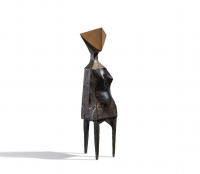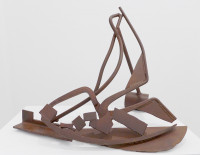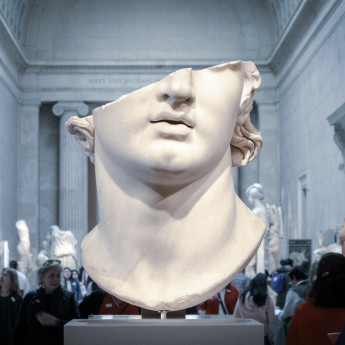
Details
Artist
Styles
// Henry Moore’s Elephant Skull (Plate A) (1969) is an etching and aquatint that forms part of a series inspired by the structure of an elephant’s skull. The artwork features an intricate, almost abstract rendering of the skull’s internal forms, with delicate, precise lines that create a complex web of shapes and contours. The layering of lines, along with the use of aquatint, gives the piece depth and texture, emphasizing the organic complexity of the skull's surface. Moore’s exploration of natural forms and their abstract qualities is evident in this piece, where he captures the monumental yet intricate details of the skull, transforming it into a study of form, space, and structure. The print is both a technical marvel and an evocative reflection of Moore’s interest in organic shapes and their relation to the human body and nature.
Elephant skull (Plate A), 1969
form
Medium
Size
67 x 55 cm
- Inches
- Centimeters
Edition
Price
- USD
- EUR
- GBP
Details
Artist
Styles
// Henry Moore’s Elephant Skull (Plate A) (1969) is an etching and aquatint that forms part of a series inspired by the structure of an elephant’s skull. The artwork features an intricate, almost abstract rendering of the skull’s internal forms, with delicate, precise lines that create a complex web of shapes and contours. The layering of lines, along with the use of aquatint, gives the piece depth and texture, emphasizing the organic complexity of the skull's surface. Moore’s exploration of natural forms and their abstract qualities is evident in this piece, where he captures the monumental yet intricate details of the skull, transforming it into a study of form, space, and structure. The print is both a technical marvel and an evocative reflection of Moore’s interest in organic shapes and their relation to the human body and nature.
- Recently Added
- Price (low-high )
- Price (high-low )
- Year (low-high )
- Year (high-low )
Henry Moore
Two Reclining Figures, 1983
Limited Edition Print
Etching And Aquatint
Currently Not Available
What is late modernism?
Late Modernism refers to the continuation and evolution of Modernist principles in art, architecture, and literature from the mid-20th century into the late 20th century. This movement maintains a focus on form, abstraction, and the rejection of traditional styles, but it often incorporates more complexity and ambiguity compared to early Modernism. Late Modernism explores themes such as alienation, identity, and the fragmentation of reality, reflecting the social and cultural shifts of the post-war period. It is seen in the works of architects like Louis Kahn and artists like Francis Bacon, who pushed the boundaries of Modernism while responding to the changing world around them.






























